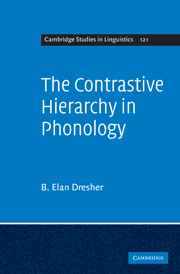Book contents
- Frontmatter
- Contents
- Acknowledgements
- 1 Introduction
- 2 The logic of contrast
- 3 Contrast in structuralist phonology
- 4 The rise and fall of the contrastive hierarchy
- 5 Generative phonology: contrast goes underground
- 6 Contrast in Optimality Theory
- 7 Evidence for the contrastive hierarchy in phonology
- 8 Other approaches to contrast in phonology
- 9 Conclusion
- References
- Index of names
- Subject index
2 - The logic of contrast
Published online by Cambridge University Press: 04 May 2010
- Frontmatter
- Contents
- Acknowledgements
- 1 Introduction
- 2 The logic of contrast
- 3 Contrast in structuralist phonology
- 4 The rise and fall of the contrastive hierarchy
- 5 Generative phonology: contrast goes underground
- 6 Contrast in Optimality Theory
- 7 Evidence for the contrastive hierarchy in phonology
- 8 Other approaches to contrast in phonology
- 9 Conclusion
- References
- Index of names
- Subject index
Summary
Contrastive specification: an elusive problem
It is far from obvious how to decide, for a given phoneme in a given language, which of its features are contrastive and which are not. The problem is made even more elusive by the fact that it does not appear to be difficult. In particular situations we may have intuitions about what the answer must be. But our common-sense intuitions may lead us astray, in this area as in others. Or we may find that we can follow more than one logical chain of reasoning, each of which may appear to be sound, but which lead to different and incompatible conclusions.
To give something of the flavour of this problem, both its seeming obviousness and real difficulty, I would like to begin with a quote from Stephen Anderson (1985:96–7). Anderson is illustrating Trubetzkoy's (1939) notion of phonemic content, intended to be the sum of the contrastive properties of a phoneme: ‘If we consider [English] /t/, for example, we can see that this segment is phonologically voiceless (because it is opposed to /d/), non-nasal (because opposed to /n/), dental (because opposed to /p/ and /k/), and a stop (because opposed to /s/ and to /θ/).’
Anderson is not proposing a detailed analysis of English; he is simply illustrating what some of the contrastive features of English /t/ would be in a Trubetzkoyan analysis, and presumably in any analysis of contrast that used these features.
- Type
- Chapter
- Information
- The Contrastive Hierarchy in Phonology , pp. 11 - 36Publisher: Cambridge University PressPrint publication year: 2009

